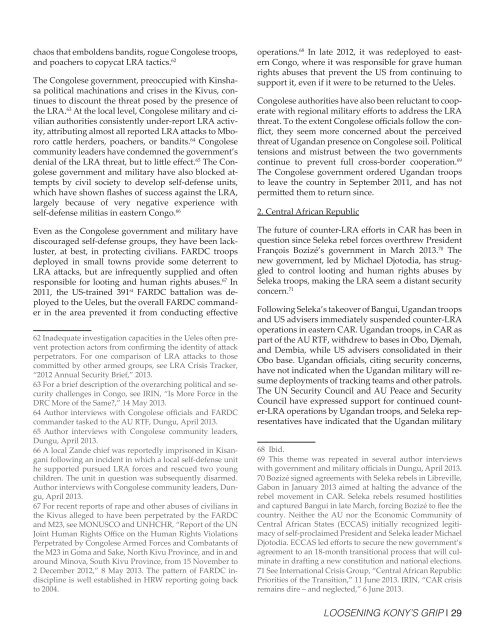Loosening-Konys-Grip-July-2013-FINAL
Loosening-Konys-Grip-July-2013-FINAL
Loosening-Konys-Grip-July-2013-FINAL
You also want an ePaper? Increase the reach of your titles
YUMPU automatically turns print PDFs into web optimized ePapers that Google loves.
chaos that emboldens bandits, rogue Congolese troops,and poachers to copycat LRA tactics. 62The Congolese government, preoccupied with Kinshasapolitical machinations and crises in the Kivus, continuesto discount the threat posed by the presence ofthe LRA. 63 At the local level, Congolese military and civilianauthorities consistently under-report LRA activity,attributing almost all reported LRA attacks to Mbororocattle herders, poachers, or bandits. 64 Congolesecommunity leaders have condemned the government’sdenial of the LRA threat, but to little effect. 65 The Congolesegovernment and military have also blocked attemptsby civil society to develop self-defense units,which have shown flashes of success against the LRA,largely because of very negative experience withself-defense militias in eastern Congo. 66Even as the Congolese government and military havediscouraged self-defense groups, they have been lackluster,at best, in protecting civilians. FARDC troopsdeployed in small towns provide some deterrent toLRA attacks, but are infrequently supplied and oftenresponsible for looting and human rights abuses. 67 In2011, the US-trained 391 st FARDC battalion was deployedto the Ueles, but the overall FARDC commanderin the area prevented it from conducting effective62 Inadequate investigation capacities in the Ueles often preventprotection actors from confirming the identity of attackperpetrators. For one comparison of LRA attacks to thosecommitted by other armed groups, see LRA Crisis Tracker,“2012 Annual Security Brief,” <strong>2013</strong>.63 For a brief description of the overarching political and securitychallenges in Congo, see IRIN, “Is More Force in theDRC More of the Same?,” 14 May <strong>2013</strong>.64 Author interviews with Congolese officials and FARDCcommander tasked to the AU RTF, Dungu, April <strong>2013</strong>.65 Author interviews with Congolese community leaders,Dungu, April <strong>2013</strong>.66 A local Zande chief was reportedly imprisoned in Kisanganifollowing an incident in which a local self-defense unithe supported pursued LRA forces and rescued two youngchildren. The unit in question was subsequently disarmed.Author interviews with Congolese community leaders, Dungu,April <strong>2013</strong>.67 For recent reports of rape and other abuses of civilians inthe Kivus alleged to have been perpetrated by the FARDCand M23, see MONUSCO and UNHCHR, “Report of the UNJoint Human Rights Office on the Human Rights ViolationsPerpetrated by Congolese Armed Forces and Combatants ofthe M23 in Goma and Sake, North Kivu Province, and in andaround Minova, South Kivu Province, from 15 November to2 December 2012,” 8 May <strong>2013</strong>. The pattern of FARDC indisciplineis well established in HRW reporting going backto 2004.operations. 68 In late 2012, it was redeployed to easternCongo, where it was responsible for grave humanrights abuses that prevent the US from continuing tosupport it, even if it were to be returned to the Ueles.Congolese authorities have also been reluctant to cooperatewith regional military efforts to address the LRAthreat. To the extent Congolese officials follow the conflict,they seem more concerned about the perceivedthreat of Ugandan presence on Congolese soil. Politicaltensions and mistrust between the two governmentscontinue to prevent full cross-border cooperation. 69The Congolese government ordered Ugandan troopsto leave the country in September 2011, and has notpermitted them to return since.2. Central African RepublicThe future of counter-LRA efforts in CAR has been inquestion since Seleka rebel forces overthrew PresidentFrançois Bozizé’s government in March <strong>2013</strong>. 70 Thenew government, led by Michael Djotodia, has struggledto control looting and human rights abuses bySeleka troops, making the LRA seem a distant securityconcern. 71Following Seleka’s takeover of Bangui, Ugandan troopsand US advisers immediately suspended counter-LRAoperations in eastern CAR. Ugandan troops, in CAR aspart of the AU RTF, withdrew to bases in Obo, Djemah,and Dembia, while US advisers consolidated in theirObo base. Ugandan officials, citing security concerns,have not indicated when the Ugandan military will resumedeployments of tracking teams and other patrols.The UN Security Council and AU Peace and SecurityCouncil have expressed support for continued counter-LRAoperations by Ugandan troops, and Seleka representativeshave indicated that the Ugandan military68 Ibid.69 This theme was repeated in several author interviewswith government and military officials in Dungu, April <strong>2013</strong>.70 Bozizé signed agreements with Seleka rebels in Libreville,Gabon in January <strong>2013</strong> aimed at halting the advance of therebel movement in CAR. Seleka rebels resumed hostilitiesand captured Bangui in late March, forcing Bozizé to flee thecountry. Neither the AU nor the Economic Community ofCentral African States (ECCAS) initially recognized legitimacyof self-proclaimed President and Seleka leader MichaelDjotodia. ECCAS led efforts to secure the new government’sagreement to an 18-month transitional process that will culminatein drafting a new constitution and national elections.71 See International Crisis Group, “Central African Republic:Priorities of the Transition,” 11 June <strong>2013</strong>. IRIN, “CAR crisisremains dire – and neglected,” 6 June <strong>2013</strong>.LOOSENING KONY’S GRIP | 29


